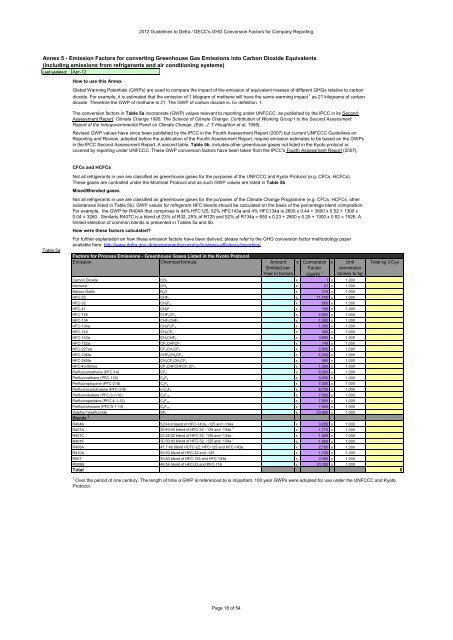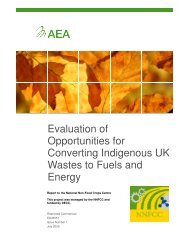Greenhouse gas conversion factors for company reporting
Greenhouse gas conversion factors for company reporting
Greenhouse gas conversion factors for company reporting
You also want an ePaper? Increase the reach of your titles
YUMPU automatically turns print PDFs into web optimized ePapers that Google loves.
2012 Guidelines to Defra / DECC's GHG Conversion Factors <strong>for</strong> Company Reporting<br />
Annex 5 - Emission Factors <strong>for</strong> converting <strong>Greenhouse</strong> Gas Emissions into Carbon Dioxide Equivalents<br />
(including emissions from refrigerants and air conditioning systems)<br />
Last updated: Apr-12<br />
How to use this Annex<br />
Global Warming Potentials (GWPs) are used to compare the impact of the emission of equivalent masses of different GHGs relative to carbon<br />
dioxide. For example, it is estimated that the emission of 1 kilogram of methane will have the same warming impact 1 as 21 kilograms of carbon<br />
dioxide. There<strong>for</strong>e the GWP of methane is 21. The GWP of carbon dioxide is, by definition, 1.<br />
The <strong>conversion</strong> <strong>factors</strong> in Table 5a incorporate (GWP) values relevant to <strong>reporting</strong> under UNFCCC, as published by the IPCC in its Second<br />
Assessment Report, Climate Change 1995. The Science of Climate Change. Contribution of Working Group I to the Second Assessment<br />
Report of the Intergovernmental Panel on Climate Change. (Eds. J. T Houghton et al, 1996) .<br />
Revised GWP values have since been published by the IPCC in the Fourth Assessment Report (2007) but current UNFCCC Guidelines on<br />
Reporting and Review, adopted be<strong>for</strong>e the publication of the Fourth Assessment Report, require emission estimates to be based on the GWPs<br />
in the IPCC Second Assessment Report. A second table, Table 5b, includes other greenhouse <strong>gas</strong>es not listed in the Kyoto protocol or<br />
covered by <strong>reporting</strong> under UNFCCC. These GWP <strong>conversion</strong> <strong>factors</strong> have been taken from the IPCC's Fourth Assessment Report (2007).<br />
CFCs and HCFCs<br />
Table 5a<br />
2<br />
Not all refrigerants in use are classified as greenhouse <strong>gas</strong>es <strong>for</strong> the purposes of the UNFCCC and Kyoto Protocol (e.g. CFCs, HCFCs).<br />
These <strong>gas</strong>es are controlled under the Montreal Protocol and as such GWP values are listed in Table 5b<br />
Mixed/Blended <strong>gas</strong>es<br />
Not all refrigerants in use are classified as greenhouse <strong>gas</strong>es <strong>for</strong> the purposes of the Climate Change Programme (e.g. CFCs, HCFCs, other<br />
substances listed in Table 5b). GWP values <strong>for</strong> refrigerant HFC blends should be calculated on the basis of the percentage blend composition.<br />
For example, the GWP <strong>for</strong> R404A that comprises is 44% HFC125, 52% HFC143a and 4% HFC134a is 2800 x 0.44 + 3800 x 0.52 + 1300 x<br />
0.04 = 3260. Similarly R407C is a blend of 23% of R32, 25% of R125 and 52% of R134a = 650 x 0.23 + 2800 x 0.25 + 1300 x 0.52 = 1526. A<br />
limited selection of common blends is presented in Tables 5a and 5b.<br />
How were these <strong>factors</strong> calculated?<br />
For further explanation on how these emission <strong>factors</strong> have been derived, please refer to the GHG <strong>conversion</strong> factor methodology paper<br />
available here: http://www.defra.gov.uk/environment/economy/business-efficiency/<strong>reporting</strong>/<br />
Factors <strong>for</strong> Process Emissions - <strong>Greenhouse</strong> Gases Listed in the Kyoto Protocol<br />
Emission Chemical <strong>for</strong>mula Amount<br />
Emitted per<br />
Year in tonnes<br />
x<br />
Conversion x Unit<br />
(GWP) 1 tonnes to kg<br />
Factor <strong>conversion</strong><br />
Carbon Dioxide CO 2 x 1 x 1,000<br />
Methane CH 4 x 21 x 1,000<br />
Nitrous Oxide N 2O x 310 x 1,000<br />
HFC-23 CHF 3 x 11,700 x 1,000<br />
HFC-32 CH 2F 2 x 650 x 1,000<br />
HFC-41 CH 3F x 150 x 1,000<br />
HFC-125 CHF 2CF 3 x 2,800 x 1,000<br />
HFC-134 CHF 2CHF 2 x 1,000 x 1,000<br />
HFC-134a CH 2FCF 3 x 1,300 x 1,000<br />
HFC-143 CH 3CF 3 x 300 x 1,000<br />
HFC-143a CH 3CHF 2 x 3,800 x 1,000<br />
HFC-152a CF 3CHFCF 3 x 140 x 1,000<br />
HFC-227ea CF 3CH 2CF 3 x 2,900 x 1,000<br />
HFC-236fa CHF 2CH 2CF 3 x 6,300 x 1,000<br />
HFC-245fa CH 3CF 2CH 2CF 3 x 560 x 1,000<br />
HFC-43-I0mee CF 3CHFCHFCF 2CF 3 x 1,300 x 1,000<br />
Perfluoromethane (PFC-14) CF 4 x 6,500 x 1,000<br />
Perfluoroethane (PFC-116) C 2F 6 x 9,200 x 1,000<br />
Perfluoropropane (PFC-218) C 3F 8 x 7,000 x 1,000<br />
Perfluorocyclobutane (PFC-318) c-C 4F 8 x 8,700 x 1,000<br />
Perfluorobutane (PFC-3-1-10) C 4F 10 x 7,000 x 1,000<br />
Perfluoropentane (PFC-4-1-12) C 5F 12 x 7,500 x 1,000<br />
Perfluorohexane (PFC-5-1-14) C 6F 14 x 7,400 x 1,000<br />
Sulphur hexafluoride SF 6 x 23,900 x 1,000<br />
Blends 2<br />
R404A 52:44:4 blend of HFC-143a, -125 and -134a x 3,260 x 1,000<br />
R407A 20:40:40 blend of HFC-32, -125 and -134a 3 x 1,770 x 1,000<br />
R407C 23:25:52 blend of HFC-32, -125 and -134a x 1,526 x 1,000<br />
R407F 30:30:40 blend of HFC-32, -125 and -134a 3 x 1,555 x 1,000<br />
R408A 47:7:46 blend HCFC-22, HFC-125 and HFC-143a x 2,795 x 1,000<br />
R410A 50:50 blend of HFC-32 and -125 x 1,725 x 1,000<br />
R507 50:50 blend of HFC-125 and HFC-143a x 3,300 x 1,000<br />
Total kg CO 2 e<br />
R508B 46:54 blend of HFC-23 and PFC-116 x 10,350 x 1,000<br />
Total 0<br />
1<br />
Over the period of one century. The length of time a GWP is referenced to is important. 100 year GWPs were adopted <strong>for</strong> use under the UNFCCC and Kyoto<br />
Protocol.<br />
Page 18 of 54








